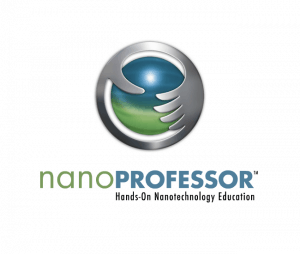NanoProfessor Increases Access to Front-Edge STEM Learning

 Nanotechnology is the next boom in science. It explores material science (chemistry, physics, biology) at the scale of one billionth of a meter, such a low level that it’s invisible to the human eye. It includes everything from nanotechnology patents that are making L’Oreal face creams more penetrable to composites used on airplanes and aerospace that are stronger and lighter than steel. It’s revolutionizing products across all industries by making them more efficient and durable than ever before.
Nanotechnology is the next boom in science. It explores material science (chemistry, physics, biology) at the scale of one billionth of a meter, such a low level that it’s invisible to the human eye. It includes everything from nanotechnology patents that are making L’Oreal face creams more penetrable to composites used on airplanes and aerospace that are stronger and lighter than steel. It’s revolutionizing products across all industries by making them more efficient and durable than ever before.
While it’s one of the fastest growing markets on the front edge of science, it’s short staffed. The National Science Foundation (NSF) predicts that by 2020 the world is going to need six million nanotechnology workers and 2.5 million support personnel. Today, we’re woefully behind at just 400,000 workers.
“Right now there’s a huge gap,” said Dean Hart, Chief Commercial Officer at NanoInk, Inc. an emerging growth technology company specializing in nanometer-scale manufacturing and applications development for the life sciences, engineering, pharmaceutical, and education industries..
What’s more, current workers in the field are primarily isolated to Ph.D. and postdoctoral positions conducting research. In order to develop the level of nanotechnology and nanoscience workers we need – especially at the technician level – we need to start training workers now.
The catch is that historically most nano-focused work and as a result most of the nano-focused training has been done in specially designed clean rooms, which can cost up to $60 to $70 million. These labs or clean rooms, which are located at major, elite universities, create controlled environments to reduce dust, germs, and more.
“To remedy the nanotechnology workforce gap you can’t very well go around the country building $60 to $70 million clean rooms,” said Hart. The high cost and low access to nanotechnology learning slows the number of students who enter the field.
Enter NanoProfessor. NanoInk, Inc. created NanoProfessor, which doesn’t require costly clean rooms, in order to teach nanotechnology and nanoscience to undergraduate students. It includes instruments, curriculum textbooks, hands-on labs, program support, training, maintenance and more for the fraction of the cost: less than $300,000.
“The catalytic step is getting the technology in the hands of the masses,” said Hart. “That’s what NanoProfessor does. The key is that NanoInk has developed a nano-focused instrument that is analogous to the first desktop computer. It allows undergraduate students to actually work at the nano-scale with a number of different compounds and without the expense of a cleanroom”
NanoProfessor, which is geared toward undergraduate students at four-year universities and 2-year technical schools or community colleges as well as some high schools, is revolutionizing the delivery of nanotechnology and nanoscience learning in classrooms.
“Once students start gaining hands-on experience with nanotechnology, you will see an incredible boom in applications and companies; and an accelerated growth in what is already a fast-growing industry,” said Hart.
Hart relates it to the IT boom in 1985, which expanded and opened minds to what is possible. He believes that NanoProfessor will help drive new knowledge, understanding, and expansion into the unknown by doing exciting work at a nanoscale.
“If we can continue to gets kids excited. If students can actually start doing things and building things below the optical level of light,” said Hart, “we believe that will excite students and maintain their interest in science.”
NSERVE, a Career and Technical Education (CTE) consortium comprised of nine large high schools in the Chicago suburbs, is working to do just that. Martha Eldredge Stark, NSERVE’s Executive Director, brought the idea of bringing NanoProfessor, which was already working with Oakton Community College near Chicago, IL, to the community’s high schools.
“I suggested that students would be much more likely to matriculate to Oakton if they could be introduced to nanotechnology at the high school level, since most people know relatively little about nanotechnology or consider it for a career pathway,” said Eldredge Stark.
Eldredge Stark worked in coordination with Assistant Superintendents for Curriculum and Instruction and CTE departments and science departments at the high schools as well as Oakton, NanoProfessor, and the Illinois Science + Tech Park to create the vision for the new program. NSERVE hopes to implement the program, which subsequently became part of the Nanotechnology Employment, Education, and Economic Development Initiative (NE3I), within the next year, training teachers, determining an implementation model, and more.
“There are many types of imaging (viewing) instruments in the marketplace that allow students to visualize different things at the nanoscale, but nothing that allows the students to actually build structures at the nanoscale,” said Eldredge Stark, excited about the prospect of teaching students nanotechnology. “NanoProfessor’s NLP 2000 allows students to do just that with both metallic nanoparticles as well as biologic materials such as lipids, DNA, and proteins.”
Eldredge Stark is excited to implement the program and sees it as opportunity to expand new learning and jobs while strengthening existing studies in STEM. Eldredge Stark added, “The concept of “stackable credentials” (certificates and/or degrees that can stand alone or be part of a pathway to a higher degree) is perfectly in alignment with our focus in CTE on career clusters and pathways.”
“The beauty of nanotechnology is that it is simply different science and CTE disciplines at a very small scale; which provides experiences and skills that translate to a host of what could be called ‘non-nano’ jobs,” said Eldredge Stark. “While learning at the nanoscale, students must also understand the macro level characteristics of biology, chemistry, electronics, material science and physics. This curriculum is beautifully aligned with the Framework for the Next Generation Science Standards.”
Not only will students have access to front-edge technology, but they will be furthering online and blended learning at the same time. The NE3I consortium developed a plan to utilize remote high-speed telecommunications technology, which will allow students to access the equipment and run labs remotely at the Illinois Science + Tech Park.
“Students and teachers will execute NanoProfessor experiments associated with the high school classroom lesson, and export the computer images of the results directly to high definition display screens in the high school classroom, providing a real-time graphical representation,” said Eldredge Stark. “The fact is that there are no nanotechnology reactions that can be seen with the naked eye, all output is only viewable on computer screens.”
She added, “Consequently, with these collaborative efforts, students see the very same images in class using these techniques as they would in the lab. We hope to complement these methods with weekly visits to the lab site to experience hands-on sessions with the equipment.”
NanoProfessor is driving down cost and delivering increased awareness of STEM jobs focused on nanotechnology and nanoscience, which will help meet the NSF’s predicted quota by 2020.
“Nanotechnology is also valuable to the STEM movement because it is a rapidly growing area that will profoundly affect every area of our lives – from pharmaceuticals and cancer treatments, to cosmetics and fabrics, to manufacturing and semi-conductors, to clean water supply,” said Eldredge Stark. “We are on the cusp of a myriad of discoveries.”
Eldredge Stark added, “NanoProfessor provides us with an opportunity to both expand our students’ knowledge in a field that will increasingly become a part of our world, and experience that knowledge in a manner that yields higher order thinking.”
“From an education perspective, nanotechnology is on a new frontier,” added Hart. “It’s a new paradigm. We’re really changing where nanotech education is taking place and who has the opportunity to learn about this exciting new level of science.”






0 Comments
Leave a Comment
Your email address will not be published. All fields are required.